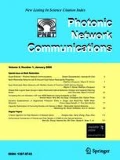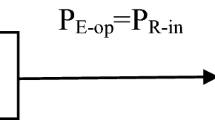Abstract
In this work we present and analyze three approaches for the adaptive control of the operating point of a cascade of erbium-doped fiber amplifiers (EDFAs), aimed at optical networks performance enhancement. The first approach is called Annealing Search Heuristic with Backpropagation and flexible output (AsHB flex) and uses machine learning concepts to update the amplifier gains through an iterative process. The second one (Exhaustive Method) uses an exhaustive search to evaluate all possible solutions for the problem and obtain the optimum solution. The last one (MaxGain) is a heuristic method that uses previous knowledge about the problem to obtain the solutions. The amplifier characteristics and specifications were obtained experimentally through measurements of gain, noise figure, gain ripple and power consumption on commercially available EDFAs. We performed comparisons among these approaches and others found in the literature, and the results show that the three proposals outperformed the previous ones in terms of noise figure, gain ripple and BER. For example, in a link with four amplifiers the Exhaustive Method achieved a reduction in the cascade noise figure from 10.05 to 5.18 dB, a reduction in the gain ripple from 24.08 to 18.56 dB and a reduction in the BER in almost two orders of magnitude, when compared with the traditional approach, which defines the gain to compensate the loss of the previous link. However, the computation time of Exhaustive Method becomes prohibitive as the number of amplifiers in the link increases. Both MaxGain and AsHBflex obtained similar solutions, close to the optimum operation point in a reasonable time.










Similar content being viewed by others
References
Movahedi, Z., Ayari, M., Langar, R., Pujolle, G.: A survey of autonomic network architectures and evaluation criteria. Commun. Surv. Tutor. IEEE 14(2), 464–490 (2012)
Khan, F.N., Zhou, Y., Sui, Q., Lau, A.P.T.: Non-data-aided joint bit-rate and modulation format identification for next-generation heterogeneous optical networks. Opt. Fiber Technol. 20(2), 68–74 (2014)
Jiménez, T., Aguado, J.: A cognitive quality of transmission estimator for core optical networks. J. Lightwave Technol. 31(6), 942–951 (2013)
Fernández, N., Durán, R.J., de Miguel, I., Merayo, N., Aguado, J.C., Fernandez, P., Jiménez, T., Rodríguez, I., Sánchez, D., Lorenzo, R.M. et al.: Survivable and impairment-aware virtual topologies for reconfigurable optical networks: a cognitive approach. In: 4th International Congress on Ultra Modern Telecommunications and Control Systems and Workshops (ICUMT), pp. 793–799. IEEE (2012)
Ishii, K., Kurumida, J., Tanizawa, K., Namiki, S., Sato, N., Ota, K., Oikawa, Y., Shiga, N.: Experimental investigation of transients in six cascaded AGC EDFAs and their suppression using a high-speed VOA. IEICE Commun. Express 1(4), 137–142 (2012). doi:10.1587/comex.1.137
Kilper, D., Waldow, M., Etter, W., Xie, C.: Control process gain of erbium doped fiber amplifiers with wavelength division multiplexed signals. In: Coherent Optical Technologies and Applications, p. JWB8. Optical Society of America (2006)
Yu, Q., Fan, C.: Simple dynamic model of all-optical gain-clamped erbium-doped fiber amplifiers. J. Lightwave Technol. 17(7), 1166 (1999)
Zirngibl, M.: Gain control in erbium-doped fibre amplifiers by an all-optical feedback loop. Electron. Lett. 27(7), 560–561 (1991)
Yunko, S., WookKim, M., HwanKim, D., HyuckKim, S., CheolJo, J., HoPark, J.: Gain control in erbium-doped fibre amplifiers by tuning centre wavelength of a fibre Bragg grating constituting resonant cavity. Electron. Lett. 34(10), 990–991 (1998)
Tian, C., Kinoshita, S.: Analysis and control of transient dynamics of EDFA pumped by 1480-and 980-nm lasers. J. Lightwave Technol. 21(8), 1728 (2003)
Agrawal, G.P.: Fiber-Optic Communication Systems, Chap. 7, 4th edn. Wiley, New York (2010)
J.R. Oliveira, A. Caballero, E. Magalh aes, U. Moura, R. Borkowski, G. Curiel, A. Hirata, L. Hecker, E. Porto, D. Zibar, et al.: Demonstration of EDFA cognitive gain control via GMPLS for mixed modulation formats in heterogeneous optical networks. In: Optical Fiber Communication Conference. Optical Society of America (2013)
Barboza, E.A., Bastos-Filho, C.J., Martins-Filho, J.F., de Moura, U.C., de Oliveira, J.R.: Self-adaptive erbium-doped fiber amplifiers using machine learning. In: Microwave and Optoelectronics Conference (IMOC), 2013 SBMO/IEEE MTT-S International, pp. 1–5. IEEE (2013)
de Moura, U.C., Oliveira, J.R., Oliveira, J.C., Cesar, A.C.: EDFA adaptive gain control effect analysis over an amplifier cascade in a DWDM optical system. In: Microwave and Optoelectronics Conference (IMOC), 2013 SBMO/IEEE MTT-S International, pp. 1–5. IEEE (2013)
Oliveira, J.R., Moura, U.C., Oliveira, J.C., Romero, M.A.: Hybrid distributed Raman/EDFA amplifier with hybrid automatic gain control for reconfigurable WDM optical networks. J. Microw. Optoelectron. Electromagn. Appl. 12(2), 602–616 (2013)
Kirkpatrick Jr., S., Gelatt, D., Vecchi, M.P.: Optimization by simulated annealing. Science 220(4598), 671–680 (1983)
Barboza, E.A., Bastos-Filho, C.J., Martins-Filho, J.F., de Moura, U.C., de Oliveira, J.R.: Mapping EDFA noise figure and gain flatness over the power mask using neural networks. J. Microw. Optoelectron. Electromagn. Appl. 12(Sl–2), 128–139 (2013)
Becker, P.M., Olsson, A.A., Simpson, J.R.: Erbium-Doped Fiber Amplifiers: Fundamentals and Technology, Chap. 7. Academic Press, London (1999)
Savory, S.J.: Digital coherent optical receivers: algorithms and subsystems. IEEE J. Sel. Topics Quantum Electron. 16(5), 1164–1179 (2010)
Godard, D.: Self-recovering equalization and carrier tracking in two-dimensional data communication systems. IEEE Trans. Commun. 28(11), 1867–1875 (1980)
Sethares, W.A., Rey, G.A., Johnson, C.: Approaches to blind equalization of signals with multiple modulus. In: International Conference on Acoustics, Speech, and Signal Processing, 1989. ICASSP-89, pp. 972–975. IEEE (1989)
Pfau, T., Hoffmann, S., Noé, R.: Hardware-efficient coherent digital receiver concept with feedforward carrier recovery for \(M\)-QAM Constellations. J. Lightwave Technol. 27(8), 989–999 (2009)
Acknowledgments
The authors would like to thank the CNPq and the Foundation for Science and Technology of Pernambuco (FACEPE) for the financial support.
Author information
Authors and Affiliations
Corresponding author
Rights and permissions
About this article
Cite this article
Barboza, E.d.A., Bastos-Filho, C.J.A., Filho, J.F.M. et al. Local and global approaches for the adaptive control of a cascade of amplifiers. Photon Netw Commun 33, 194–207 (2017). https://doi.org/10.1007/s11107-016-0633-4
Received:
Accepted:
Published:
Issue Date:
DOI: https://doi.org/10.1007/s11107-016-0633-4




